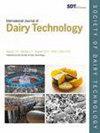Cow’s milk components with anti-cancer potential
引用次数: 50
Abstract
Milk contains a number of components with anti-cancer potential. Associated with the fat phase is conjugated linoleic acid (CLA), which is a potent inhibitor of mammary tumourigenesis and perhaps has a role in prostate cancer therapy. Sphingomyelin and other sphingolipids suppressed colon tumour development in mice. Butyric acid, uniquely present in milk, can inhibit mammary tumour occurrence in rats while 13-methyltetradecanoic acid suppressed cell growth in a number of human cancer cell lines and inhibited the growth of human prostate and liver cancer cells implanted in mice. Milk lipids also contain the common anti-cancer agents β-carotene and vitamin A. Milk protein, particularly whey protein and its components, have potent anb-tumour action in animal models of colon and mammary tumourigenesis. In this regard whey is superior to other proteins such as beef and soy. This benefit is considered to be due to the content of the sulphur amino acids cysteine and methionine, which are precursors of glutathione, a powerful cellular antioxidant. Glutathione is also responsible for maintaining an effective immune response. Recently a number of studies demonstrated that bovine lactoferrin could inhibit tumour development in the rodent colon, lung, oesophagus, bladder and tongue. In addition, lactoferrin can inhibit angiogenesis and prevent metastases. Milk is a rich source of calcium. A large number of animal studies and human epidemiological and intervention studies suggest calcium can help prevent colon adenoma and carcinoma. Les composants du lait ayant des proprietes anticancereuses sont presentes ici: L'acide linoleique conjugue, la sphingomyeline et les autres sphingolipides, l'acide butyrique, l'acide 13-methyltetradecanoique, les proteines du lait dont la caseine, les proteines du lactoserum dont la lactoferrine, le calcium. Les mecanismes et sites d'action sont presentes.具有抗癌潜力的牛奶成分
牛奶含有许多具有抗癌潜力的成分。与脂肪相关联的是共轭亚油酸(CLA),它是一种有效的乳腺肿瘤发生抑制剂,可能在前列腺癌治疗中起作用。鞘磷脂和其他鞘脂抑制小鼠结肠肿瘤的发展。乳汁中特有的丁酸能抑制大鼠乳腺肿瘤的发生,而13-甲基十四烷酸能抑制多种人类癌细胞系的细胞生长,并能抑制植入小鼠体内的人类前列腺和肝癌细胞的生长。牛奶中的脂肪还含有常见的抗癌物质β-胡萝卜素和维生素a。牛奶中的蛋白质,尤其是乳清蛋白及其成分,在结肠和乳腺肿瘤发生的动物模型中具有强大的抗肿瘤作用。在这方面,乳清优于其他蛋白质,如牛肉和大豆。这种益处被认为是由于含硫氨基酸半胱氨酸和蛋氨酸的含量,它们是谷胱甘肽的前体,谷胱甘肽是一种强大的细胞抗氧化剂。谷胱甘肽还负责维持有效的免疫反应。近年来的多项研究表明,牛乳铁蛋白可以抑制啮齿动物结肠、肺、食道、膀胱和舌头的肿瘤发展。此外,乳铁蛋白可以抑制血管生成和防止转移。牛奶是钙的丰富来源。大量的动物研究和人类流行病学和干预研究表明,钙可以帮助预防结肠腺瘤和癌。研究发现:L’酸亚油酸共轭物、L’酸鞘磷脂、L’酸丁酸、L’酸13-甲基十四烷酸、L’酸酪氨酸蛋白、L’酸乳血清蛋白、L’酸乳铁氨酸、L’钙。这种机制使网站无法进行动作呈现。
本文章由计算机程序翻译,如有差异,请以英文原文为准。
求助全文
约1分钟内获得全文
求助全文

 求助内容:
求助内容: 应助结果提醒方式:
应助结果提醒方式:


